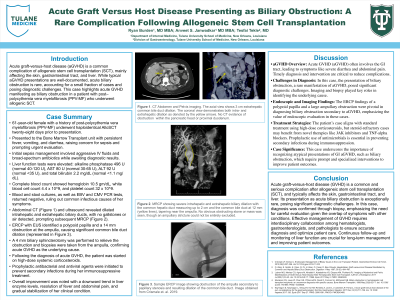Monday Poster Session
Category: Biliary/Pancreas
P1852 - Acute Graft vs Host Disease Presenting as Biliary Obstruction: A Rare Complication Following Allogeneic Stem Cell Transplantation
Monday, October 28, 2024
10:30 AM - 4:00 PM ET
Location: Exhibit Hall E

Has Audio

Ryan Burden, MD, MBA
Tulane School of Medicine
New Orleans, LA
Presenting Author(s)
Ryan Burden, MD, MBA1, Duncan Pearce, MD2, Tesfai Tekle, MD1
1Tulane School of Medicine, New Orleans, LA; 2Tulane Medical Center, New Orleans, LA
Introduction: Acute graft versus host disease (GVHD) is a common complication following allogeneic stem cell transplantation (SCT), primarily affecting the skin, gastrointestinal tract, and liver. However, its presentation as acute biliary obstruction is exceedingly rare and can pose diagnostic challenges. Herein, we present a case of acute GVHD manifesting as biliary obstruction in a patient with a history of post–polycythemia vera myelofibrosis (PPV-MF) who underwent haploidentical allogeneic SCT.
Case Description/Methods: A 61-year-old female with a medical history of PPV-MF status post haploidentical allogeneic stem cell transplant (AlloSCT) 28 days prior presented with fever, vomiting, and diarrhea. She was admitted to the Bone Marrow Transplant unit for sepsis. Liver function tests showed elevated alkaline phosphatase (496 U, normal 40-120), alanine aminotransferase (80 U, normal 30-65), aspartate aminotransferase 92 U, normal < 35), and total bilirubin (2.2 mg/dL, normal < 1.1). Blood analysis revealed hemoglobin 10.5 gm/dL, white blood cell count 4.4 x 109, and platelet count 32 x 109. The sepsis was controlled with intravenous fluids and antibiotics. Blood and stool cultures taken from admission were negative, as were EBV and CMV PCR. An abdominal CT scan and ultrasound revealed severe dilation of the intra- and extrahepatic biliary ducts up to 3 cm without evidence of gallstones or air. Endoscopic retrograde cholangiopancreatography (ERCP) with endoscopic ultrasound (EUS) revealed a polypoid papilla and dilation of the common bile duct to 14 mm in diameter with an obstruction at the ampulla level. A biliary sphincterotomy was performed and biopsies taken from the ampulla subsequently confirmed acute GVHD. She was started on high dose systemic corticosteroid and prophylactic antibacterial, antifungal, and antiviral agents. The liver enzymes down trended and the fever and abdominal pain resolved.
Discussion: Acute GVHD involving the gastrointestinal tract commonly presents with symptoms such as diarrhea, abdominal pain, and gastrointestinal bleeding. However, its presentation as biliary obstruction is exceptionally rare and can mimic other conditions, including malignancy. Prompt recognition of this atypical presentation is crucial to avoid unnecessary interventions and initiate appropriate immunosuppressive therapy. This case underscores the importance of a multidisciplinary approach involving gastroenterologists, hepatologists, and transplant specialists in the management of post-SCT complications.
Disclosures:
Ryan Burden, MD, MBA1, Duncan Pearce, MD2, Tesfai Tekle, MD1. P1852 - Acute Graft vs Host Disease Presenting as Biliary Obstruction: A Rare Complication Following Allogeneic Stem Cell Transplantation, ACG 2024 Annual Scientific Meeting Abstracts. Philadelphia, PA: American College of Gastroenterology.
1Tulane School of Medicine, New Orleans, LA; 2Tulane Medical Center, New Orleans, LA
Introduction: Acute graft versus host disease (GVHD) is a common complication following allogeneic stem cell transplantation (SCT), primarily affecting the skin, gastrointestinal tract, and liver. However, its presentation as acute biliary obstruction is exceedingly rare and can pose diagnostic challenges. Herein, we present a case of acute GVHD manifesting as biliary obstruction in a patient with a history of post–polycythemia vera myelofibrosis (PPV-MF) who underwent haploidentical allogeneic SCT.
Case Description/Methods: A 61-year-old female with a medical history of PPV-MF status post haploidentical allogeneic stem cell transplant (AlloSCT) 28 days prior presented with fever, vomiting, and diarrhea. She was admitted to the Bone Marrow Transplant unit for sepsis. Liver function tests showed elevated alkaline phosphatase (496 U, normal 40-120), alanine aminotransferase (80 U, normal 30-65), aspartate aminotransferase 92 U, normal < 35), and total bilirubin (2.2 mg/dL, normal < 1.1). Blood analysis revealed hemoglobin 10.5 gm/dL, white blood cell count 4.4 x 109, and platelet count 32 x 109. The sepsis was controlled with intravenous fluids and antibiotics. Blood and stool cultures taken from admission were negative, as were EBV and CMV PCR. An abdominal CT scan and ultrasound revealed severe dilation of the intra- and extrahepatic biliary ducts up to 3 cm without evidence of gallstones or air. Endoscopic retrograde cholangiopancreatography (ERCP) with endoscopic ultrasound (EUS) revealed a polypoid papilla and dilation of the common bile duct to 14 mm in diameter with an obstruction at the ampulla level. A biliary sphincterotomy was performed and biopsies taken from the ampulla subsequently confirmed acute GVHD. She was started on high dose systemic corticosteroid and prophylactic antibacterial, antifungal, and antiviral agents. The liver enzymes down trended and the fever and abdominal pain resolved.
Discussion: Acute GVHD involving the gastrointestinal tract commonly presents with symptoms such as diarrhea, abdominal pain, and gastrointestinal bleeding. However, its presentation as biliary obstruction is exceptionally rare and can mimic other conditions, including malignancy. Prompt recognition of this atypical presentation is crucial to avoid unnecessary interventions and initiate appropriate immunosuppressive therapy. This case underscores the importance of a multidisciplinary approach involving gastroenterologists, hepatologists, and transplant specialists in the management of post-SCT complications.
Disclosures:
Ryan Burden indicated no relevant financial relationships.
Duncan Pearce indicated no relevant financial relationships.
Tesfai Tekle indicated no relevant financial relationships.
Ryan Burden, MD, MBA1, Duncan Pearce, MD2, Tesfai Tekle, MD1. P1852 - Acute Graft vs Host Disease Presenting as Biliary Obstruction: A Rare Complication Following Allogeneic Stem Cell Transplantation, ACG 2024 Annual Scientific Meeting Abstracts. Philadelphia, PA: American College of Gastroenterology.
